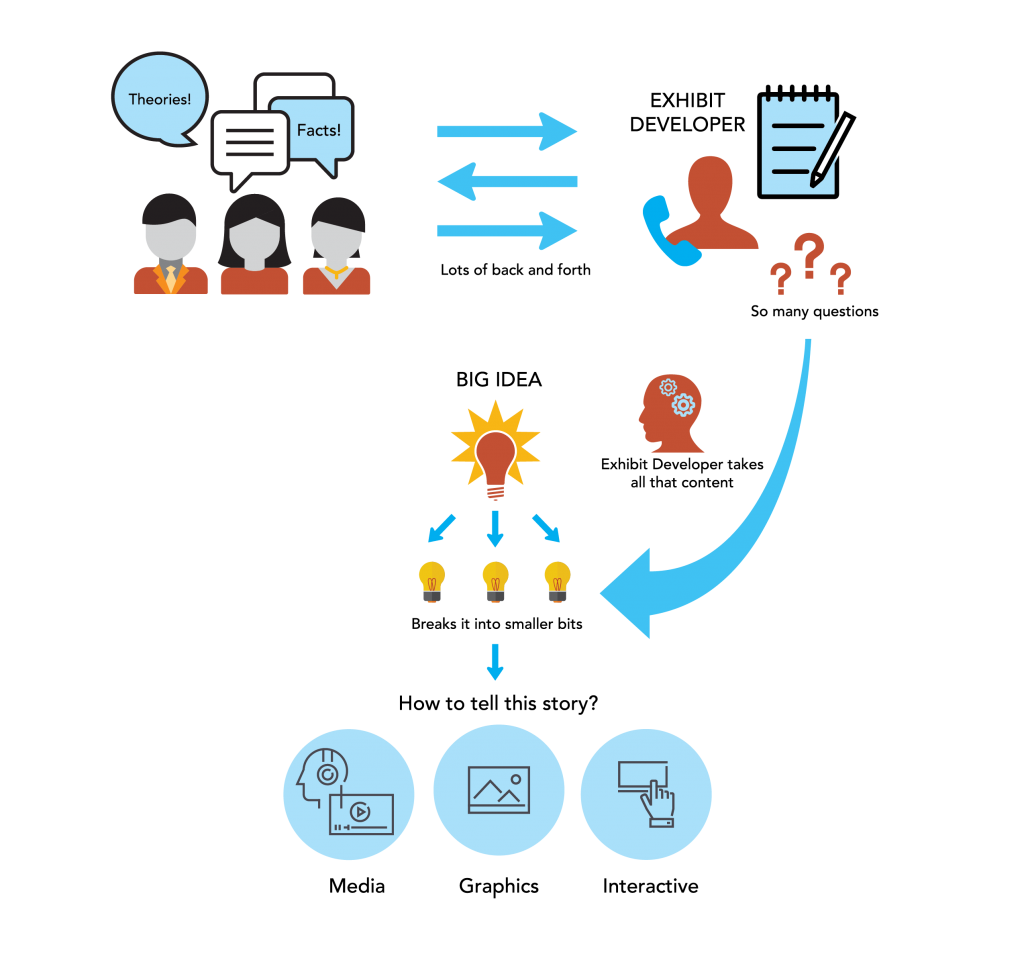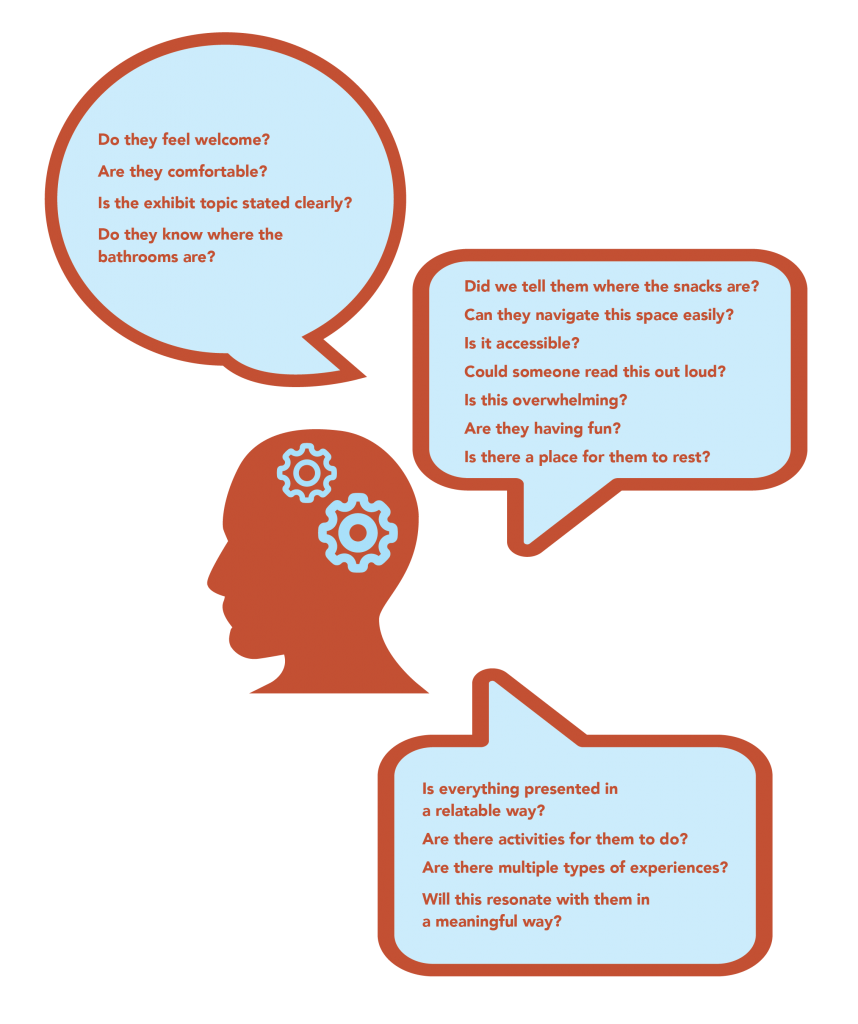If you’ve ever wondered why SIE sometimes has longer breaks between blog posts, there’s a very simple and logical reason for that: we aren’t professional bloggers. We have other jobs at SIE, and those responsibilities come first. So, while we love to keep people up-to-date on the blog, working on the exhibits is more important than writing about working on the exhibits.
The blog posts are, for the most part, written by SIE’s exhibit developer/writers.
This is where I realize there’s a pretty good chance that a lot of people reading this are thinking:
What is an exhibit developer?
Well, like a lot of jobs, it really depends on where you work. At SIE the exhibit developers are also writers. In some places, the exhibit developers are also project managers. I’m sure there’s countless combinations out there that museums developed as they figured out what works best for their process. And as always, if you work somewhere small, the position descriptions get to be somewhat all encompassing. One of my earlier jobs included (among many other things) exhibit research, script writing, bookkeeping, and on Thursday it was my day to take out the trash. My point is, there’s no one-size-fits-all exhibit developer job description.
Because the SIE exhibit developers are also writer/editors, we have a variety of projects that come our way. Everything from copyediting completed scripts to developing and writing an entire exhibit from the ground up. But most people have a sense of what a writer does … for example … this thing you’re reading now? I wrote it.
Exhibit developers, however, are one of those jobs that probably didn’t come up with your high school guidance counselor. I ended up in this field and I didn’t know it was a job until I was in an internship in college.
There are a few key roles, though, that I think define exhibit developers at SIE.
Content Wrangler

Exhibit developers are content wranglers. We work with the subject area experts to figure out the best way to tell their story. This way the subject matter expert (for example: historian, chemist, anthropologist, special agent, civil engineer, horticulturalist, etc.) can provide all the information (and review the exhibit script for accuracy), and let the exhibit developers figure out how to turn that into a holistic experience for the museum visitors. Sometimes that means we do some of the research, other times, someone hands over source material. Most of the time it falls somewhere in between. There’s always a lot of back and forth with the content experts as we figure out ways to explain what they know to an audience unfamiliar with the topic.
Script Editor / Writer

At SIE, we might help edit the script, or in some projects, like The FBI Experience or Mission: DIA, we write it ourselves. We also have to keep in mind that visitors might not know much about the topic. Museum writing is different than writing an article or a book. We need to write in a way that is understandable in more than one order. The main thing to consider when writing for an exhibition is that museums are a spatially driven experience. Visitors move through an exhibition. Museums aren’t textbooks (for a lot of reasons) but let’s concentrate on the order of information for now. In a textbook, it’s fair to assume that the reader will read the chapters in order. By chapter 4, the author can expect that the reader at least glanced at chapters 1 through 3. Exhibitions work more like an anthology: the ideas are all connected, but if you skip around, it should still make sense.
We still make sections clear so visitors can see when they are moving into a new topic. But, while a building’s design might dictate how a visitor gets from one gallery to another, there is no way to guarantee that a visitor will go through the space in any particular order (and even if they do, they might not have a chance to read everything along the way).
Visitor Advocate

We think about visitors. A lot. We heart you, visitors. We try figure out how a visitor would navigate an exhibit. Would they likely follow it in an order? Is there a place where they might have to wait (for example, at an interactive element)? What if that went through it and only looked at the objects? Could they still get a positive experience? What if they only looked at the pictures and read the titles and captions?
Ideally, we like to think that visitors will read everything, and do every interactive, and watch every video clip. But we also live in the real world and understand that sometimes the kids are just done and you have to leave. Or you were lucky enough to have an extra 30 minutes one day and popped into a Smithsonian and just wanted to see something you hadn’t seen before. We want you to engage with the exhibit however works best for you on that visit. Walking into a gallery, sitting on a bench, and enjoying one piece of art is a fantastic way to experience a museum. So is reading every panel if that’s what you want to do. Museums are for everyone, and exhibit developers want you to have an experience that works for you.
Also, we want to make sure you know where the bathroom is and where you can get a coffee. We’re people, too, and we also need those things.
Those are the highlights of the job, but as with any job those “duties as assigned” always come into play. Sometimes it’s a little extra help editing a press release, or maybe we’ll help select images since we’re the ones immersed in the story. But no matter what, exhibit developers want you to enjoy your time in our museums, learn a cool fact or two, and—if we’ve really nailed it—look at an object, story, topic, or (dare I hope) the world in a different way.

